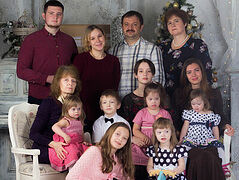Christmas toys made of cotton wool, traditional in the Soviet period but practically forgotten in recent history, made their debut and were sold at this year’s annual “Journey to Christmas” festival kiosks in Moscow. The are made at the “Moscow Toy” manufactory, founded in 2018 by fashion designer Svetlana Modnova. While the majority of craftswomen keep their leisure pursuits as a hobby while others turn it into a source of additional income, Svetlana was able to win over several thousand people with her idea, by teaching, and organizing and opening a production facility. This facility employs representatives of one of the most vulnerable social groups—mothers of children with special needs.
—Svetlana, how did you become interested in cotton wool toys?
—In 2017 my family and I moved from Sochi to Moscow. Moscow is above all a city of opportunities. It offers so many exhibitions, workshops, and conferences that no other region of Russia has ever held. I was busy attending all sorts of events; And then, one day, I saw an advertisement in a magazine offering a cotton wool toy-making workshop. There were also photos of those toys. An idea immediately popped into my head: If someone can make them, why can’t I? I signed up and came. A few hours later, I had my first figurine and after that, the cotton wool toy has captured my heart forever.
—Why were you so fascinated by it?
—First of all, it is so adorable. Secondly, like many other Russian women, it is natural for me to do handicrafts. I can knit, sew, and decorate; in other words, I make a lot of things by hand. But if, for example, knitting or embroidery doesn’t bring a quick result, and you see the final product only after a few weeks, then making a cotton wool toy takes a little time. You can make a simple figurine in an hour out of cotton wool from the pharmacy. And you can model anything you want! Cotton wool is like a story without beginning or end—it allows you to make animals, people, birds, fruit, flowers... If you are an artist, you can mold anything you want out of it. But even if you are not an artist, yet you have a the taste and desire —you’ll still be able to do it. Your end result probably won’t look professional, but it will still look nice.
—How did your hobby turn into a whole new factory?
—My second degree is in management. I really enjoy implementing large-scale projects and turning ideas into reality. At the same time, I do not yet know the final outcome of the project—no story has an end for me, I see myself as someone who develops a multi-stop itinerary and then travels from one point to another. But it is also exciting to reach intermediate results, as well.
I started looking for a community of craftspeople who make cotton wool toys, in order to get to know and learn from them, but then I realized that everyone is working on their own. There are beginners, and famous artisans, but everyone is on their own. At the time, there was no professional community in Russia, so I created it. In 2018, we registered the autonomous non-profit organization “Family Traditions” Handicraft Center. And only later, the Moscow Toy Factory was founded under its auspices.
 —What did you do at the Center first?
—What did you do at the Center first?
—We started by organizing workshops for those who wanted to learn the art of making cotton wool toys. When the attendance figures grew way too high, we realized we didn’t have enough resources, and so I wrote my first application to the Presidential Grants Fund, then the second and the third one... We received several grants to train the mothers of children, and, as of today, three and a half thousand Russian women from different parts of the country have attended our workshops.
When I started this project, my wish was that people wouldn’t simply learn a new craft, but they’d be able to change their lives because of this craft. I think we have achieved amazing results! Ninety percent of the artisans working with us today are mothers of children with special needs. They would first come to our sessions with sad faces and sour moods, but with the hope that they could find creative escape from the life’s challenges and that it could change their life. By their third, fifth, or seventh visit, these women would already come with new hairstyles, their eyes sparkling, and excited to meet other girls in the factory. After completing their training, some stayed at home and made cotton wool toys as a hobby—making gifts together with their children, much to the delight of their close and distant friends. Some made these toys to order, working from home. Many of them wanted to learn how to run workshops on their own.
The women feel like they are experts, capable of creating masterpieces, selling and giving them away as gifts
The women feel like they are experts, capable of creating masterpieces, and selling or giving them away as gifts. They feel that they are needed by having mastered the beautiful craft of cotton wool toy making. Many of them go to work in cultural centers, schools and kindergartens; they also run hobby groups for making cotton wool toys. Approximately one hundred women who went through our project are working for our factory on a self-employed basis, fulfilling corporate orders. There are craftswomen who work at home, while we collect their finished products and help to sell them in our Museum of cotton wool toys.
In other words, our program consisted of three stages: we taught—we produced—and we helped to sell.
—Why were you talking about it in the past tense? Is it no longer possible to go through a training course with you?
—The project had limited timeframe, as it was made possible by support from the Presidential Foundation for Cultural Initiatives. Over the course of two years, our team held seven hundred free online workshops all over Russia. Ten of the best artists, masters of cotton wool toys, taught our women the proprietary technology. At this point, we no longer have new resources to pay the artists who hold the workshops, so we can only accept someone who either already has basic skills, or shows great desire, diligence and has an art education.
—Where else do you sell toys besides the Museum?
—We have a lot of corporate clients: the Government of Moscow, Sberbank, GLONASS, “Zenit” soccer club, various institutes and universities. This year, in March, we will sign our first contracts and approve toy samples.
As for retail, you can find our toys in the Stockmann retail chain. We have also received an invitation to present our products in the chain of “Book Expedition” stands of the Presidential Administration located in government offices.
This year, we became participants of the “Made in Moscow” project and were featured at the “Journey to Christmas” festival. The best artisans of our factory held a series of workshops on cotton wool toys, while our goods could be purchased at several booths on Manezhnaya Square, in Gorky Park and Butovo. More than five hundred toys were sold at the festival. Can you imagine what a support it was for the moms in our project?
—Aren’t buyers deterred by pricing?
—A cotton wool toy can’t be cheap, as it takes about five days to make it if you do a high quality and technologically sound piece of work, using the natural drying method. A simple vintage toy can be made in a few hours, but making a professional original toy is a long process. We want our toys to stay in people’s homes for many years, so we dry them naturally, which means for several days. Then comes the process of the original meticulous painting, varnishing, and pastel work... Each piece is handmade from start to finish.
—How did you select the items for the exhibit at the Museum of Cotton Wool Toys?
—We purchased these items at auctions, and asked the parishioners of our churches, who brought some unique toys; We also worked with various collectors... We purposefully collected figurines from different time periods and eras. There are molded figurines, pressed, hand shaped, wound, not wound... We tell about all of these details during a tour in our museum. We have already collected more than ninety pieces; some of them are currently traveling around Russia to be shown at exhibitions.
 The artisans of the Factory of the Cotton Wool Toys
The artisans of the Factory of the Cotton Wool Toys
—The factory and museum are located on the territory of the Nikolo-Perervinsky monastery. Are you a parishioner there?
—No, I am a parishioner of the Holy Archangel Michael Church in Troparevo-Nikulino. But when I am at the museum, I attend services in the church of the Nikolo-Perervinsky monastery. All of our women artisans are also churchgoers who often do readings at services. When we were looking for premises, by God’s providence we met Father Vladimir, the abbot of the monastery, and he kindly offered us a beautiful large eighteenth-century cell for our activities. This is where we hold workshops and tours.
Even the ancient fathers of the Church said: “Pray and work.” It is important to be an example of hard work and show your faith with deeds, not with words. That’s why I have two rules in my life —to work and to believe, and believe implicitly.
—You mentioned that there is no end to each project for you. What is the next destination on your itinerary?
—This year, we have plans to develop equipment that would partially automate the toy making process. It will allow us to reduce the price and make our products more accessible to a wide range of people. We want to reproduce the technological processes that existed in the Soviet artisan groups—this way, we will be able to bring in women who can perform technologically uncomplicated jobs. Of course, if we manage to get the equipment production going, we will need to look for a more spacious facility.
We also plan to create a truly beautiful collection tentatively titled “I am Russian.” The artists of the factory will present the history of Russia through names and personalities widely recognized in the world in the form of a traditional cotton wool toy. Through toys, the project will tell about the contribution of Russians in fields of science, culture, diplomacy, and military art.
Our team has many plans! May God give us all health and strength, and also more time.








